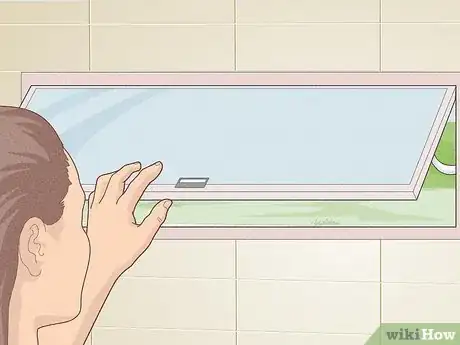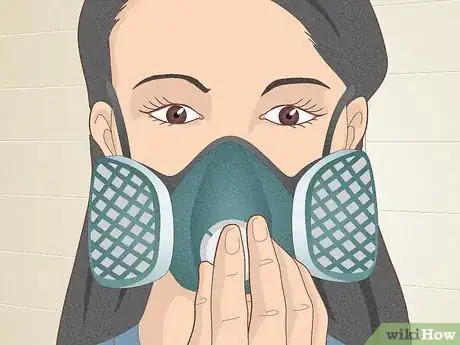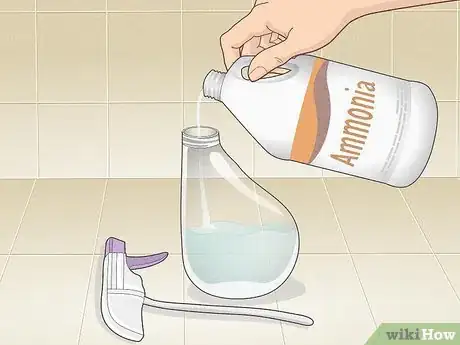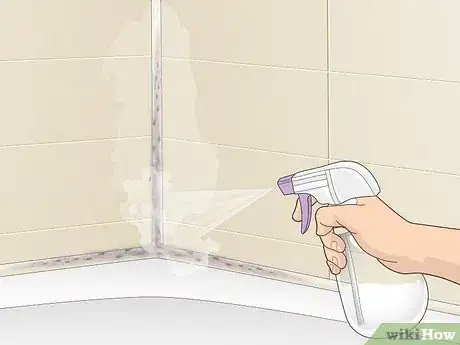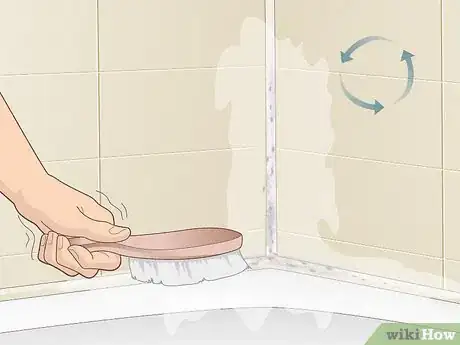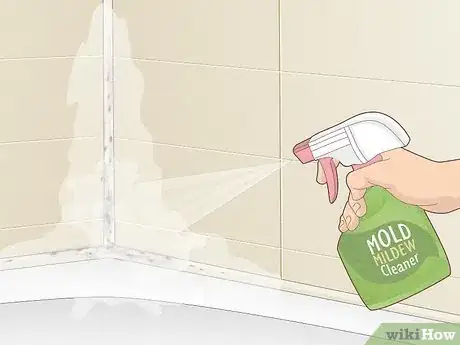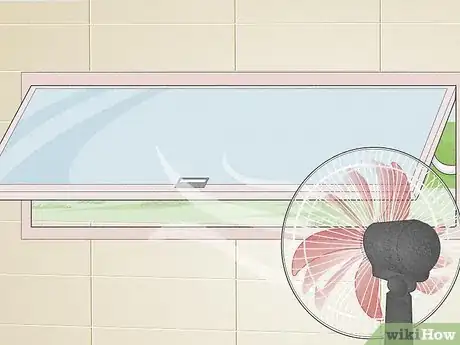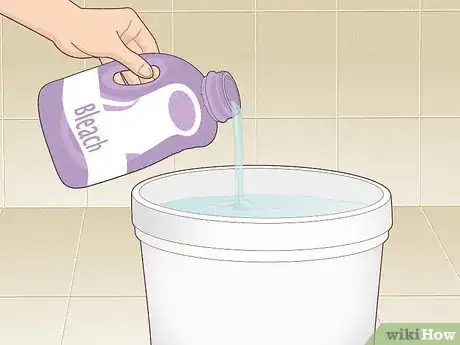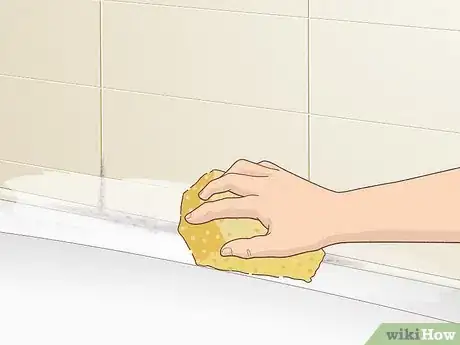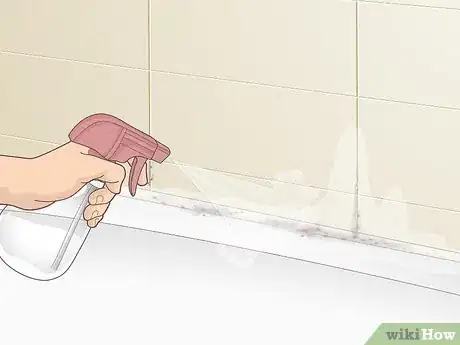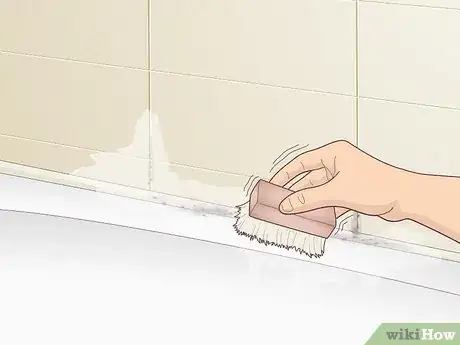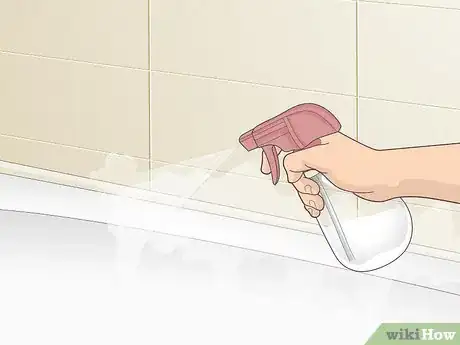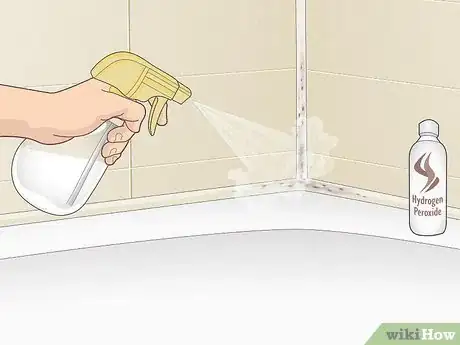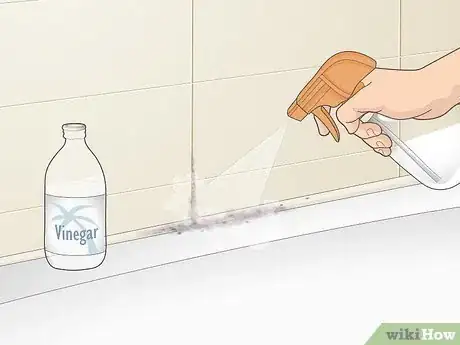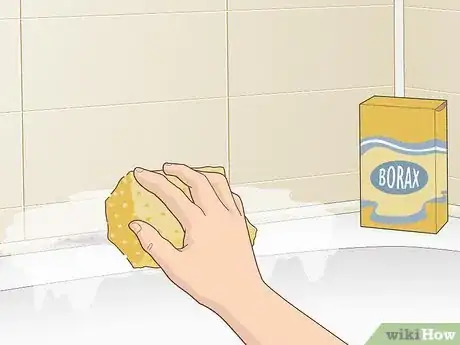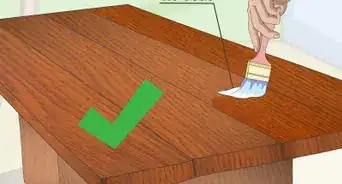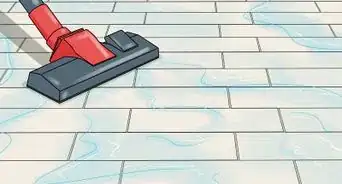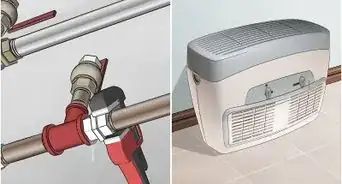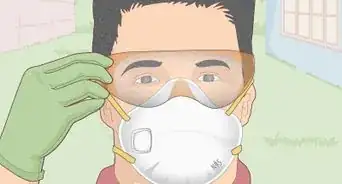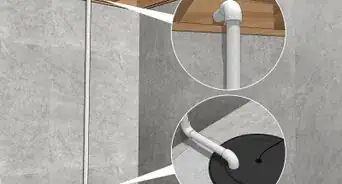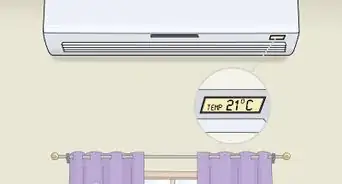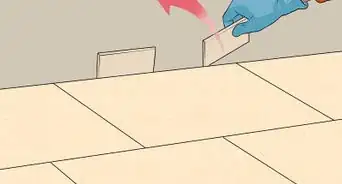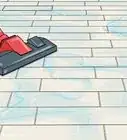This article was co-authored by Ashley Matuska. Ashley Matuska is a Professional Cleaner at the Founder and Owner of Dashing Maids in Denver, Colorado. Ashley has over seven years of experience in the cleaning industry. She and her team specialize in offering sustainable deep cleaning and maintenance cleaning services.
wikiHow marks an article as reader-approved once it receives enough positive feedback. In this case, 100% of readers who voted found the article helpful, earning it our reader-approved status.
This article has been viewed 435,935 times.
Removing and replacing old caulk can be a time-consuming project if it starts growing mold. Thankfully, this may not be necessary to get rid of your mold problem. Try cleaning the caulk first with common household staples like ammonia or bleach (be sure NOT to mix these two chemicals or use at the same time!). These are proven mold killers up to a certain point, but as harsh as they are, other non-toxic household items (like vinegar and baking soda) often prove to do an even better job!
Steps
Using Ammonia
-
1Ventilate the area. Keep in mind that ammonia can have harmful effects when inhaled. Improve the air circulation. Open windows and doors, switch on exhaust fans, and/or set up other fans to get the air moving.[1]
-
2Wear a respirator. Chances are that in areas like bathrooms, your options for improving airflow are pretty limited. In this case, be sure to wear a respirator that will filter out the fumes. Or just wear one anyway to be extra safe- A plain paper face mask depicted in the graphic will not protect you from ammonia fumes. You need an activated charcoal cartridge respirator fitted to seal to your face and designed to absorb ammonia. Many hardware stores can assist you in finding the right respirator, and you can also find more information about them online..[2]Advertisement
-
3Make your solution. First, improve the ventilation in the area you’re mixing this if you’re doing so somewhere other than the area that needs cleaning. Then mix equal parts ammonia and water either directly in a spray bottle or another container before pouring the mix into your bottle with a funnel.[3]
-
4Spray and scrub. Once your solution is mixed, squirt an even amount over the moldy caulk. Wait five to ten minutes for it to settle in and start killing the mold. Then scrub the sprayed caulk with a small brush. Wipe the caulk down with a cloth or paper towels to remove all traces when finished.
-
5Repeat and evaluate. If the first application didn’t kill or remove all the mold, try again. If repeated tries don’t seem to be doing anything, use another cleaner. Keep in mind that ammonia can be an effective mold killer with non-porous surfaces, but often has difficulty with porous ones like caulk.[4]
-
6Use another cleaner if the problem returns. Be aware that caulk may look clean after you’ve scrubbed and wiped it down, but mold may still be present. If it reappears soon after your attempt with ammonia, treat this as a sign that the mold’s roots are too deep in the caulk for the ammonia to reach it effectively. Move on to another solution.[5]
Using Bleach
-
1Expect the same risks and limitations. Ventilate the area as you would when using ammonia. Also be aware that chlorinated bleach has the same difficulty with porous surfaces. Consider bleach as an alternative only if you don’t have any ammonia on hand (or if you would just rather use bleach for whatever reason). If you’ve already tried ammonia, skip the bleach, since it probably won’t do any better of a job.[6]
- Additionally, keep in mind that bleach and ammonia create toxic fumes when mixed. So if you’ve already sprayed the caulk with ammonia, don’t follow it up with bleach.
-
2Make your solution. Measure 1 cup (237 ml) of chlorinated bleach. Pour it into 1 gallon (3.75 L) of water. Stir until it’s evenly mixed.
-
3Scrub light mold with a soaked sponge. If your mold problem is pretty light, grab a fresh sponge. Soak it in your solution and squeeze out the excess. Then simply scrub the moldy caulk with that.[7]
-
4Spray more pronounced problems before scrubbing. If a quick scrub with a soaked sponge doesn’t do the job by itself, fill a spray bottle with your solution. Mist the moldy caulk and give it five or ten minutes to settle into the caulk. Then wipe it down again with your sponge.
-
5Repeat with a cleaning brush. If the sponge still isn’t cutting it, spray the caulk again. Give the bleach time to reach the mold’s roots. Then scrub again, only this time use a bristled cleaning brush.[8]
-
6Treat deeply rooted problems with cotton coils. If spraying the caulk doesn’t seem to be enough for the bleach to reach the mold’s roots, switch to cotton coils. Soak these in your solution. Place them along your caulk line and nudge them into it with a Q-tip. Leave them overnight so the caulk can soak up as much bleach as possible. Then scrub it down again in the morning.[9]
-
7Spray the caulk again once cleaned. Remove mold and other dirt by wiping down the caulk with a cloth or paper towels. Then spray the area again with your solution and let it be. Prevent new mold from growing by keeping this active agent in place.[10]EXPERT TIPAshley Matuska is a Professional Cleaner at the Founder and Owner of Dashing Maids in Denver, Colorado. Ashley has over seven years of experience in the cleaning industry. She and her team specialize in offering sustainable deep cleaning and maintenance cleaning services.Professional Cleaner

 Ashley Matuska
Ashley Matuska
Professional CleanerContinue to be diligent in your cleaning. Ashley Matuska of Dashing Maids says: "Bleach is excellent for killing mold, and it can often turn faded and discolored grout back to its original color. In the future, though, the best thing you can do is to be diligent about cleaning on a regular basis. If the mold is growing in the shower area, dry the walls and the door of your shower every time you use it, because mold can build up very quickly."
Using Non-Toxic Mold Killers
-
1Use 3% hydrogen peroxide. First, check the ingredients to make sure it has a concentration of 3%. Then simply fill a spray bottle with the stuff and spray the caulk until it’s thoroughly soaked. Give the cleaner ten minutes to settle in, and then scrub the caulk with a sponge, brush, or both. Wipe the area clean when finished.[11]
-
2Go with vinegar. Use white distilled vinegar, not any other fancier varieties that you might have in the pantry. Fill a spray bottle and then soak the moldy caulk with it. Let it soak for one hour, then wipe the mold away with a sponge and rinse with water.[12]
-
3Use baking soda with water. Measure a ¼ tablespoon of baking soda. Dump this in a spray bottle. Fill the bottle with water and shake it up. Spray the affected area once and then wipe it clean immediately with a sponge or brush. Then rinse the caulk line with water and spray again to stop mold from growing back.[13]
-
4Try a borax-and-water solution. Add 1 cup (204 g) of borax to 1 gallon (3.75 L) of water. Either soak a sponge in the solution and soak the mold with that, or fill a spray bottle and mist the caulk. Then scrub it down with a brush and wipe it clean.[14]
Community Q&A
-
QuestionThe grout in my tub has mold, how do I get rid of the mold behind the grout?
 Debra BishCommunity AnswerThe mold on grout and caulking can be removed with salt and vinegar. If that doesn't work, rinse well, and try a bleach and water solution - use about a cup of bleach in a gallon of water. Be sure you're wearing rubber gloves and protective eye goggles. Scrub the grout with a scrub brush using the bleach and water.
Debra BishCommunity AnswerThe mold on grout and caulking can be removed with salt and vinegar. If that doesn't work, rinse well, and try a bleach and water solution - use about a cup of bleach in a gallon of water. Be sure you're wearing rubber gloves and protective eye goggles. Scrub the grout with a scrub brush using the bleach and water. -
QuestionWill removing black caulking around tub harm my cat after it's off?
 Community AnswerIt could. You should always clean up the area thoroughly once you're finished and dispose of the garbage where pets and kids can't reach it.
Community AnswerIt could. You should always clean up the area thoroughly once you're finished and dispose of the garbage where pets and kids can't reach it. -
QuestionI need to clean/whiten caulk that's been blackened by mold. I can't use bleach or ammonia. Would hydrogen peroxide or white vinegar be effective?
 Community AnswerMake a paste of hydrogen peroxide and baking soda. Let it sit for 10 minutes and then scrub with a brush. Wash clean with a wet cloth.
Community AnswerMake a paste of hydrogen peroxide and baking soda. Let it sit for 10 minutes and then scrub with a brush. Wash clean with a wet cloth.
Warnings
- Always wear appropriate eye and hand protection when using cleaners.⧼thumbs_response⧽
- Store bought mold-and-mildew killers sometimes contain ammonia, so always check their ingredients before using in conjunction with bleach.[15]⧼thumbs_response⧽
Things You’ll Need
- Respirator
- Gloves
- Protective eyewear
- Sponge
- Cleaning brush
- Paper towels or cloths
- Measuring cups and spoons
- Spray bottle
- Cotton coils (optional)
References
- ↑ https://www.howtoremoveblackmold.com/how-to-kill-black-mold.html
- ↑ https://www.howtoremoveblackmold.com/how-to-kill-black-mold.html
- ↑ https://www.howtoremoveblackmold.com/how-to-kill-black-mold.html
- ↑ https://www.howtoremoveblackmold.com/how-to-kill-black-mold.html
- ↑ https://www.howtoremoveblackmold.com/how-to-kill-black-mold.html
- ↑ https://www.howtoremoveblackmold.com/how-to-kill-black-mold.html
- ↑ https://www.howtoremoveblackmold.com/how-to-kill-black-mold.html
- ↑ https://www.howtoremoveblackmold.com/how-to-kill-black-mold.html
- ↑ http://tiphero.com/remove-mold-from-shower-bathtub/
- ↑ https://www.howtoremoveblackmold.com/how-to-kill-black-mold.html
- ↑ http://www.maids.com/blog/3-non-toxic-ways-to-clean-mold/
- ↑ http://www.maids.com/blog/3-non-toxic-ways-to-clean-mold/
- ↑ http://www.maids.com/blog/3-non-toxic-ways-to-clean-mold/
- ↑ https://www.howtoremoveblackmold.com/how-to-kill-black-mold.html
- ↑ https://www.howtoremoveblackmold.com/how-to-kill-black-mold.html
About This Article
To remove mold from caulk, start by spraying the caulk with 3 percent hydrogen peroxide and letting it sit for 10 minutes. Then, scrub the caulk with a sponge and wipe the area clean. You can also try spraying the caulk with white vinegar and letting it sit for an hour before rinsing the vinegar off. If you have some baking soda on hand, you can add 1/4 teaspoon of it to some water in a spray bottle and then spray the caulk with it. Then, immediately wipe it off with a sponge and repeat. To learn how to remove mold from caulk using ammonia or bleach, keep reading!
